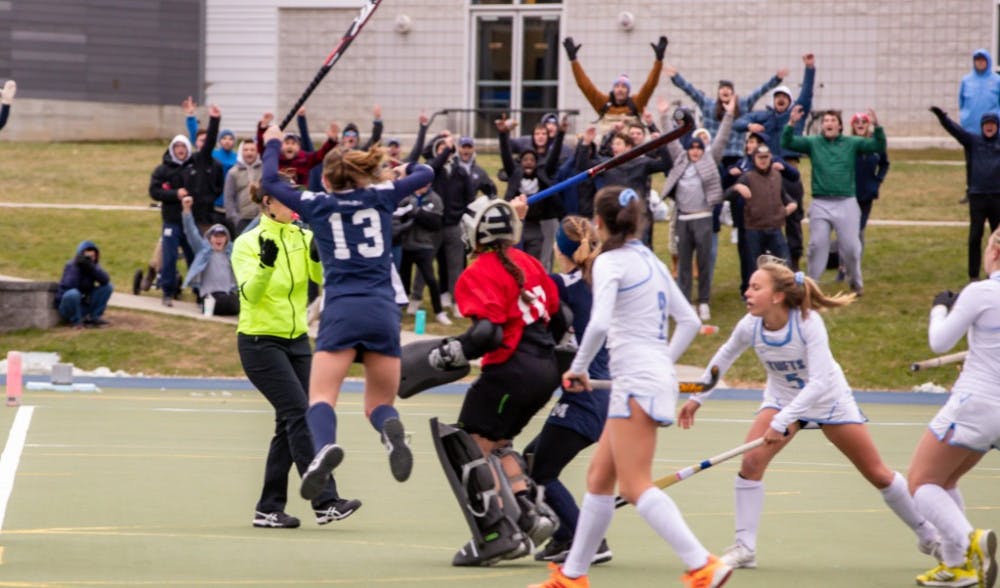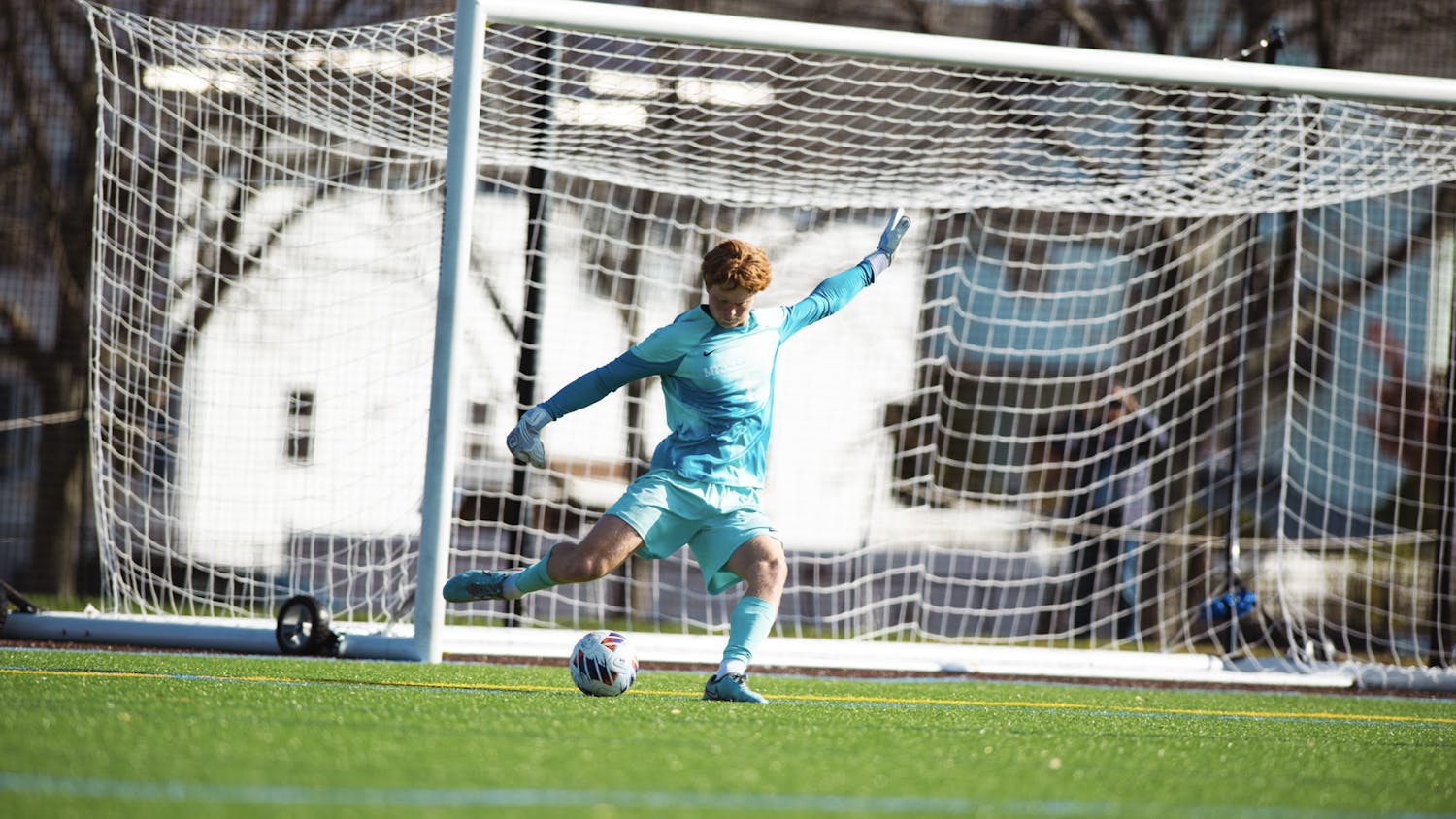Since the NESCAC lifted its ban on NCAA play before the 1993–94 season, Middlebury has won 38 National Championships in Division-III. In fact, between 1994 and 2019, there have only been six years where the Panthers haven’t won a national championship in at least one sport.
Over the years, Middlebury has cultivated a tradition of athletic dominance across all 31 varsity teams. From men’s hockey to women’s soccer to men’s alpine skiing, Middlebury squads consistently rank in the upper echelon of Division-III athletics. Since 1994, eight different teams have won an NCAA National Championship, while most others have at least clinched NESCAC titles.
But how is Middlebury’s athletic excellence celebrated? Are fan sections particularly big? Are they loud and rowdy? And what traditions do fans have, if any?
The answers to those questions aren’t simple. In short, there are stark differences in fan support across sports.
https://datawrapper.dwcdn.net/dhFEV/5/
It’s hard to characterize these numbers as “good” or “bad,” but they begin to tell the story of fan support at Middlebury. Not only are some sports dramatically more popular than others, but there is a sizable gap between genders. The average fan attendance for men’s sports was 310 people in 2019 — excluding football — and 136 people for women’s teams.
One way to measure the strength of these numbers is to compare our home attendance to that of other Division-III schools. By comparing home and away attendance records in 2019 – 20, it is clear that most Middlebury teams play in front of smaller crowds when at home than other schools do. In fact, only three Middlebury teams average more fans at home than away: men’s basketball, men’s hockey, and football.
Keep in mind that Middlebury is one of the largest NESCAC schools, with over 2,500 students, and most non-conference games are played against other small, rural colleges. Therefore, there isn’t much of an excuse: our home fan attendance, for most sports, is well below average.
https://datawrapper.dwcdn.net/c8fvN/3/
“I think so much of athletic pride right now is friends of the players — and I think it's a great place to start but it can go further than that,” said Ellie Barney ’21.5, a four-year member of women’s hockey. “Let’s figure out how to boost that overall. Most people who go to Middlebury are athletic, outdoorsy and high-energy people, and there's no reason why that shouldn’t transfer into going to games. I think we can definitely improve on fan attendance.”
“The challenge is getting more support from people who are not necessarily athletes,” women’s lacrosse head coach Kate Livesay ’03 emphasized. “It’s drawing more folks who don't have an immediate connection to the game.”
As Athletic Director Erin Quinn ’86 notes, Middlebury students are “all busy” and “engaged in a lot of different activities.” Middlebury is also a Division-III school, so sports don’t attract the same crowds that nationally followed institutions like Clemson University, University of Alabama or Ohio State University might.
But there’s room to improve regardless, and this sentiment is especially felt by student-athletes who attended high schools with large fan sections.
Walker Coleman ’23, for example, is a member of men’s football who went to high school in South Carolina. There, attendance numbers are steep and fan support is a large component of school spirit.
“It's definitely a change of scene for sure,” Coleman said. “At Midd, everyone’s a bit more tame. There are always a couple rowdy fans but it's definitely a big difference from high school. There’s not as much passion in the fan section as there was in high school.”
Through the years, there have been efforts to improve fan attendance at Middlebury, though many of the proposed solutions have either fizzled out or completely failed.
A few years ago, the Middlebury Student-Athlete Advisory Committee (SAAC) designed an app to promote fan support by giving fans points for every game they attended. Fans could exchange points for prizes, such as Middlebury apparel. While the SAAC was confident in the structure of the app, plans eventually caved since the day-to-day management was too demanding. However, the idea is still cited by many athletes today, and many want to see more time invested into the app or a slight rebuild take shape.
Other ideas to increase support include inter-team partnerships, where squads from different seasons will pair up and support one another throughout the year. The Athletics Department has pushed this initiative, and while it has been successful in some cases, Quinn notes that the best solutions will come from the students.
“If student-athletes are really interested in trying to promote more fans, they have the best access to them — it's their peers they are trying to appeal to,” Quinn said. “Top-down administration efforts sometimes miss the mark, so [the effort] has to be organically student-driven.”
Tailgating is one potential solution that students frequently suggest, though there’s more to that puzzle than most students understand. In fact, Middlebury has a troubled history with tailgates, causing Quinn and the administration to ban alcoholic beverages — and thus the typical concept of “tailgating” — in 2014. Quinn said there were repeated issues over a years-long span.
“Tailgates really became an opportunity for large groups of students to probably have a place where they felt like they could have a large party without registering for it,” Quinn said. “That might be fine, but it got to the point where there was lots of damage, incredibly disrespectful behavior and it was over a period of years. We would have to assign several public safety members just to be in that area, and we didn’t have a professional event management crew.”
Unlike other schools, Middlebury doesn’t have many, if any, traditions for fans, which also weighs down attendance numbers. One way to change this, according to Coleman, is by creating themes before big rivalry matches, such as wearing navy and white before a match against Williams or Amherst.
Perhaps the most promising channel to grow support, though, is social media. Between Instagram, Facebook, Snapchat and the many other platforms Middlebury students use, social media has emerged as the easiest way for students to communicate virtually.
“I know Middlebury Athletics has a lot of followers on Instagram, and I would love to see Instagram stories promoting games,” women’s tennis co-captain Emily Bian ’21 said. “I honestly think that would work pretty well.”
“There are so many Instagram accounts at Middlebury, so if we get a pretty wide fan base onto one Insagram account, I think that could be pretty serious, and we could really get people’s attention,” Coleman added.
It’s important to note that while many athletes believe fan support can improve, many still harbor a strong sense of appreciation and fondness for the support they do receive.
“At a school like Middlebury, it's so great because you know such a majority of people, even if it's not your closest friends,” Bian said. “It's like, ‘Oh, I recognize her from some Art History class. That’s cool that she’s sitting here and supporting my team.’ When I see people at tennis matches, it encourages me to attend other things as well — it's a domino effect.”
“You play better when there are people in the stands,” Barney said. “That noise component is fun.”
Some sports do attract larger crowds than others — like the football, men’s basketball and men’s hockey teams — where crowd sizes can reach into the thousands. For student-athletes competing in these sports, the appreciation for fans is particularly steep.
“I'm super proud of the school spirit at Middlebury,” Tommy Eastman, a co-captain of men's basketball, said. “It makes it so much more fun. You feel like an important part of the community.”
“Fan support and seeing your fellow classmates on the sidelines gives you a sense of legitimacy — like people are noticing your hard work,” Livesay added. “It gives friends a window into the hard work and sacrifice that goes into playing at a really high level. It's just fun to share this passion we have for lacrosse with other people.”
With plans to return to a “new normal” next fall, fans will likely be permitted at all sporting events, affording students a chance to revive their Panther spirit. Livesay hopes this news will generate increased fan support at Middlebury – since students have been deprived of attending live events for so long — hopefully setting a precedent.
“I feel like it's an exciting time because people haven’t been able to watch live sports in a long time,” Livesay said. “My hope, and almost expectation, is that we’ll see a lot more people in the fall because it's not something they’ve been able to do in a while. Let's hope there's a dramatic change there and that it's sustained in the future.”

Blaise Siefer ‘23.5 is a sports staff writer.
Siefer is majoring in Sociology and minoring in Spanish.
For three semesters in 2021 and 2022, Siefer served as Senior Sports Editor. He also co-founded a Middlebury sports recap podcast, PFL Weekly, which is released on all major streaming platforms every Tuesday.
Siefer is also the Co-Founder and Co-President of Middlebury Club Soccer.




